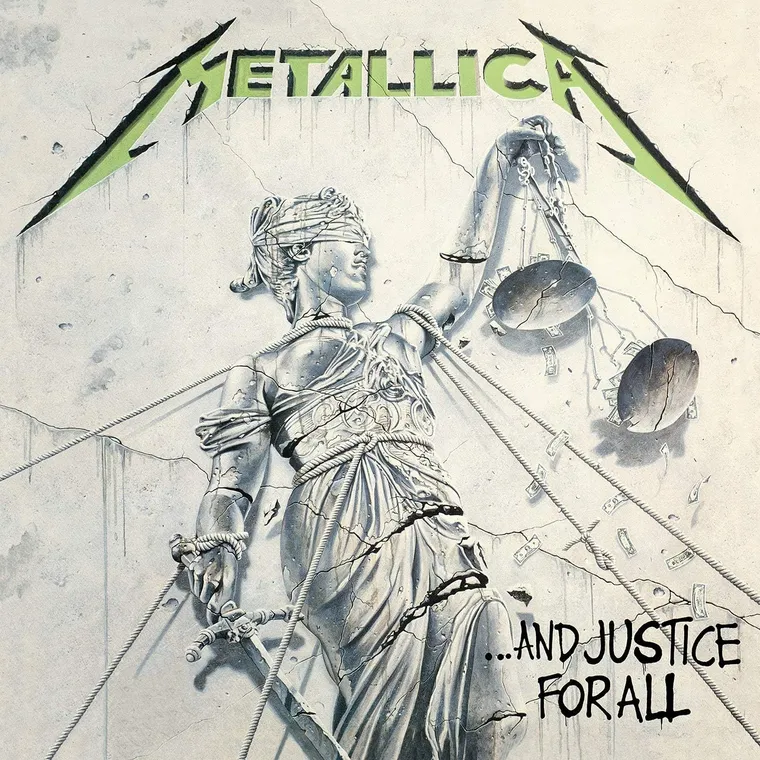7Released on September 7, 1998, Metallica’s fourth studio album—...And Justice for All—wasn’t just the next chapter in the band’s evolution. It was a declaration of artistic ambition that pushed the boundaries of what metal could be.
Coming off the tragic loss of bassist Cliff Burton, Metallica returned not just to mourn, but to create something monumental. At a time when thrash was becoming faster and more chaotic, Metallica chose complexity, structure, and scale. The result is a dense, cerebral, and uncompromising album that dares listeners to engage on a deeper level.
Where previous albums sharpened the band’s attack, Justice expanded their vision. The songs got longer, the arrangements more intricate, and the lyrics more politically and socially conscious. It wasn’t made for radio—it was made for the thinking metalhead, the headbanger who wanted more than just speed and volume. This wasn’t just music—it was architecture.
A New Chapter: Complexity, Precision, and Controlled Chaos
While Master of Puppets flirted with progressive structures, ...And Justice for All dives headfirst into them. These songs are labyrinthine, shifting between time signatures, riff changes, and lyrical themes with surgical precision. At times it feels less like a collection of songs and more like a metal symphony—brooding, intelligent, and relentless.
The production—often criticized for its dry, treble-heavy sound and nearly inaudible bass—actually reinforces the album’s aesthetic. It's cold, clinical, and razor-sharp. And while Jason Newsted's bass may be buried, his presence is still felt in the album’s tightness and weight. The guitar tones are jagged and aggressive, Lars Ulrich’s drumming is militaristic and mechanical, and James Hetfield delivers his most venomous vocal performances to date.
Monumental Tracks and Unyielding Vision
Opening with the haunting acoustic intro of “Blackened,” the album wastes no time setting a grim tone. When the full band kicks in, it’s a sonic explosion—thrash riffing, galloping rhythms, and apocalyptic lyrics. It’s aggressive, but purposeful.
The title track, “...And Justice for All,” stretches past nine minutes and never loses its grip. Built on shifting grooves and elaborate structures, it’s an indictment of a broken legal system—delivered with conviction and complexity.
“One” remains the album’s most iconic moment. Beginning as a sorrowful ballad and ending in a mechanized assault, it’s Metallica at their most cinematic. The machine-gun drums, the bleak lyrics about a war-torn soldier’s suffering, and the dramatic solo section make it one of the most powerful metal songs ever written.
Tracks like “Eye of the Beholder” and “The Shortest Straw” carry an almost punk energy filtered through a progressive lens, while “Harvester of Sorrow” slows things down to a doom-laden crawl—showcasing Metallica’s ability to groove without sacrificing intensity.
“Dyers Eve,” the album’s closer, is one of the fastest and most personal tracks in the band’s catalog. Hetfield’s lyrics are raw and cathartic, and the music matches his fury beat for beat.
The Band: Grieving, Gritty, and Grown Up
James Hetfield is in full command here—not only as a rhythm guitarist whose down-picking stamina is near inhuman, but also as a frontman coming into his own. His lyrics are more topical, introspective, and direct than ever before.
Lars Ulrich’s drumming is tighter, more varied, and more disciplined than in previous outings. While some criticize his reliance on click-track precision, there’s no denying his intricate arrangements help shape the album’s controlled chaos.
Kirk Hammett leans heavily on melody and phrasing throughout. His solos aren’t just fast—they’re thematic. He’s less about flash here and more about weaving emotion into every lead break.
And though Jason Newsted’s bass lines were notoriously dialed down in the final mix, his energy and work ethic helped anchor the band during this emotionally turbulent era. His presence, even if obscured, gave the band the foundation to move forward.
Production and Legacy: A Blueprint for Progressive Metal
Produced by Flemming Rasmussen (his third collaboration with the band), ...And Justice for All is sonically stark, almost punishing in its precision. It's not warm or forgiving—it’s cold and cerebral. And that’s by design. It sounds like the album cover looks: a cracked statue of blind justice, bound and broken.
Though criticized at the time for its long songs, dry mix, and perceived lack of low end, Justice has aged into a cult favorite. It inspired a generation of progressive and technical metal bands, proving that metal could be brainy without losing its brawn.
And despite its complexity, the album was a breakthrough moment commercially. “One” gave Metallica their first music video and their first Grammy win. Stadiums followed soon after. This wasn’t just underground thrash anymore—it was high-concept metal that could sell millions.
Final Verdict: 9.0/10
...And Justice for All is a towering achievement in heavy music. It may not be the most accessible Metallica record, but it’s one of the most rewarding. It’s a demanding listen, but for those willing to engage, it offers endless depth.
This was Metallica stepping into adulthood—facing grief, anger, and injustice head-on, and translating it into something epic. The riffs are monumental, the lyrics biting, and the ambition undeniable. It's a landmark in progressive thrash, and a reminder that metal can be as intellectually provocative as it is emotionally powerful.
More than three decades later, Justice still stands tall—not just as a product of its time, but as a timeless example of metal at its most daring.

